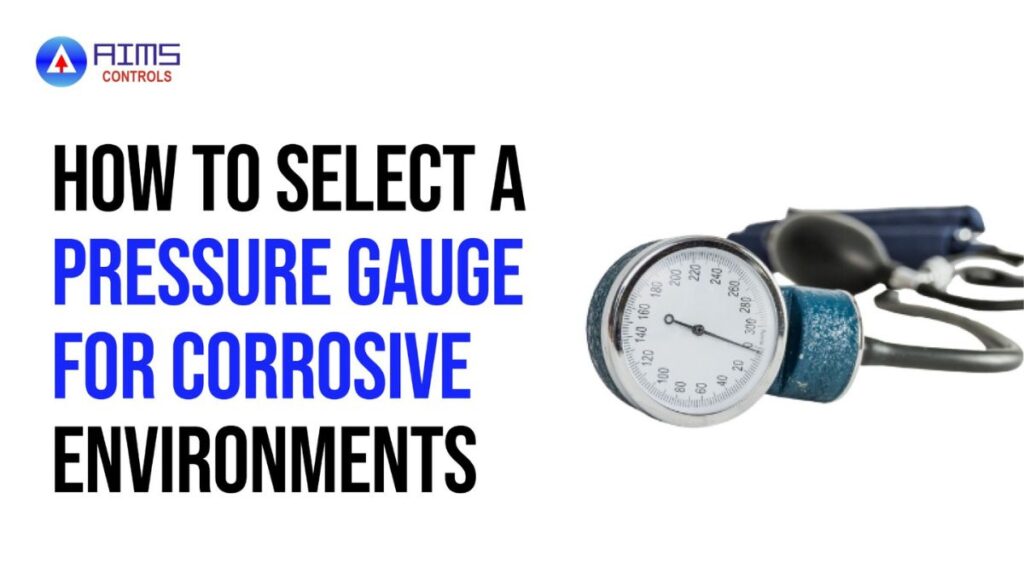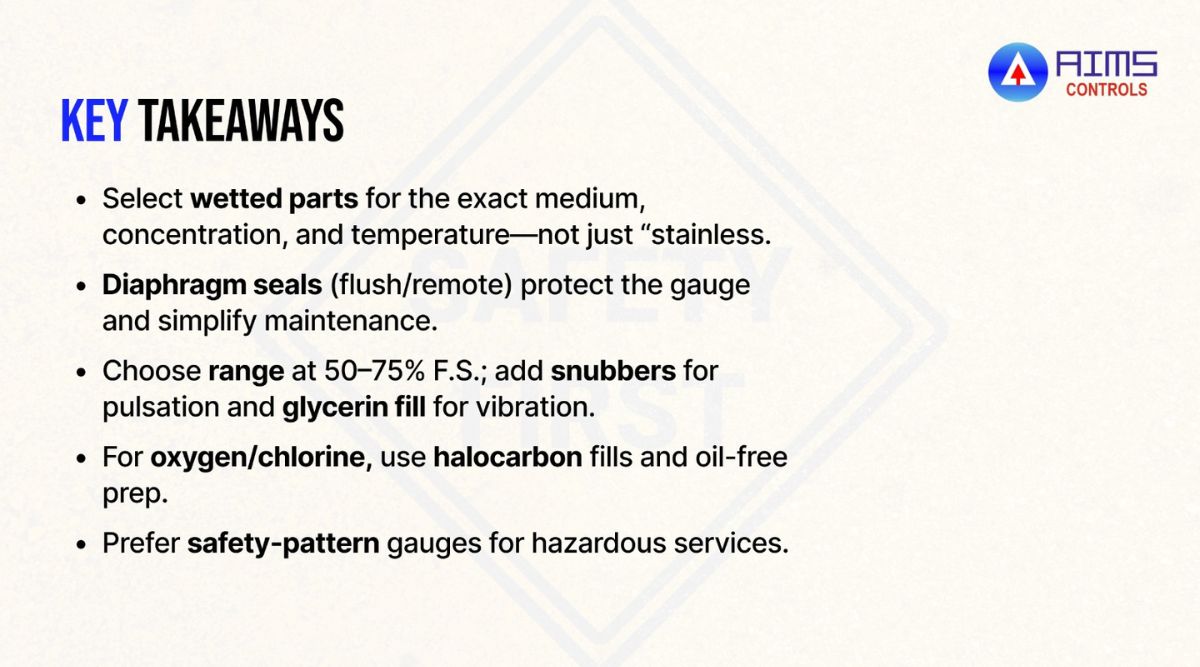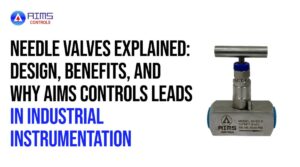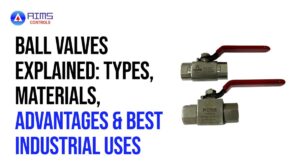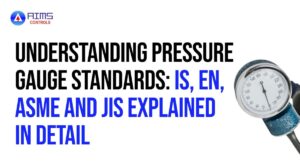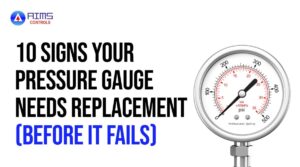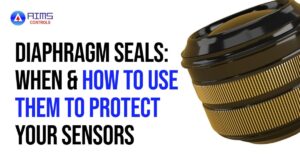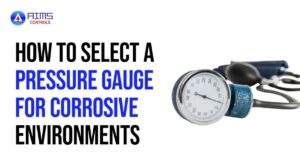Selecting a pressure gauge for corrosive service isn’t just about choosing “stainless steel.” Chemistry, temperature, viscosity, pulsation, and even cleaning agents can destroy a gauge if the wetted parts and isolation method aren’t matched to the medium. This guide shows you how to choose materials, seals, fill fluids, and ranges—plus proven product options from AIMS.
- Identify the medium (chemical name), concentration, and temperature.
- Map wetted parts to the medium: SS316L / Monel 400 / Hastelloy C-276 / PTFE-lined / Tantalum.
- Add a diaphragm seal (flush/remote) for corrosive, viscous, crystallizing, or hot media.
- Choose a compatible fill fluid (e.g., halocarbon for oxygen/chlorine service).
- Size the range so normal pressure is at 50–75% of full scale; pick accuracy class.
- Specify mounting, connection, IP rating, and vibration control (glycerin fill, snubber).
What Makes an Environment “Corrosive”?
Corrosion Modes
- Uniform corrosion: Even wall loss across surfaces.
- Pitting (chlorides): Localized attack—common risk for austenitic steels in chloride brines.
- Stress-corrosion cracking (SCC): High temp + tensile stress + chlorides.
- Galvanic corrosion: Dissimilar metals in conductive media.
Process Factors That Accelerate Attack
Concentration, temperature, aeration, solids, and flow velocity all matter. Hot acids and chloride-rich environments dramatically increase risk.
What Actually Fails
The bourdon tube and socket are the primary wetted parts in a bare gauge. In sealed systems, the diaphragm and seal internals become the critical wetted elements.
Material Selection: Picking the Right Wetted Parts
Use the medium’s MSDS and known compatibility charts as your baseline, then add temperature and concentration. The table below is a practical starting point:
| Medium / Service | Typical Choice (Wetted Parts) | Notes |
| General chemicals, light acids/alkalis | SS316/316L | Good all-rounder; watch high-temp chlorides. |
| Seawater / Brine / Chlorides | Monel 400 or SS316L + PTFE-lined seal | Monel resists chloride pitting better than SS. |
| Strong oxidizing acids / Mixed acids + chlorides | Hastelloy C-276 | High resistance across complex chemistries. |
| Hydrofluoric acid (HF) | Monel 400 (with care) | Avoid glass; consult compatibility and temp limits. |
| Hydrochloric / Sulfuric acids (various conc.) | PTFE/PFA-lined diaphragm or Tantalum-faced | Tantalum is excellent for many strong acids (not HF). |
| Caustic alkalis (NaOH/KOH) | Monel 400 or Hastelloy C-276 | Consider temperature and concentration. |
| Sour gas (H₂S) | Hastelloy or SS316L with proper seal | Solid-front safety gauge recommended. |
| Solvents (aromatics/ketones) | PTFE-lined seal or Hastelloy | Check seal fill fluid compatibility too. |
Note: Case material can be SS304/SS316 for durability, but wetted parts determine chemical compatibility.
Do You Need a Diaphragm Seal (and Which One)?
You need a diaphragm seal when the medium is corrosive, viscous, crystallizing, slurry-laden, or hot—or when you must keep the bourdon tube pristine (e.g., food, pharma, oxygen service).
Seal types:
- Threaded inline seal: Compact isolation for clean lines.
- Flush diaphragm seal: Prevents clogging; ideal for viscous or crystallizing fluids.
- Flanged seal: For large lines and easy cleaning.
- Remote seal with capillary: Keeps the gauge away from heat or vibration; great near reactors and hot lines.
Fill fluids (inside the seal system):
- Silicone oil (general purpose) for broad range and temperature stability.
- Halocarbon oil for oxygen/chlorine service (non-flammable, non-reactive).
- High-temp silicone for hot processes.
- Food-grade oils for hygienic applications.
Helpful accessories:
Flushing ring (cleaning between seal and process), snubber/restrictor (dampens pulsation), siphon (for steam), block & bleed/monoblock valves (maintenance).
Range, Accuracy & Safety
- Range sizing: Normal operating pressure should sit at 50–75% of full scale to improve accuracy and allow over-pressure events without damage.
- Accuracy classes: 1.0% (critical), 1.6% (process standard), 2.5% (utility).
- Safety features: For hazardous media, use solid-front safety pattern with blow-out back and a laminated window. This directs energy away from the operator if the tube ruptures.
Mounting, Connections & Environment
- Threads: BSP or NPT; match the wetted material (SS316L/Alloy) to the process.
- Orientation: Bottom entry for pipe runs; back entry + clamp for panels.
- Ingress & ambient: Aim for appropriate IP rating. For vibration, use glycerin-filled gauges and/or a snubber. For heat, consider remote capillary or a siphon.
Special Notes: Oxygen & Chlorine Service
- Oil-free degreasing is mandatory for oxygen service.
- Use halocarbon fill fluids; avoid hydrocarbon oils.
- Label clearly and maintain strict cleanliness protocols.
Lifecycle, Calibration & Maintenance
- Inspection: Look for pointer jitter, zero shift, and fogging.
- Cleaning: Use the flushing ring on diaphragm seals; avoid media-incompatible solvents.
- Calibration: Verify at least annually; request ISO-traceable certificates.
- Spares: Keep a spare seal diaphragm kit and one complete gauge assembly for critical lines.
Worked Examples
1) HCl Transfer Line at 60 °C
- Risk: strong acid + temperature → severe attack on brass/SS.
- Solution: PTFE-lined flush diaphragm seal + remote capillary to move the gauge away from heat. Halocarbon fill fluid. Safety-pattern gauge, 1.6% accuracy, range chosen for 50–75% F.S.
2) Seawater Brine Skid (Chlorides)
- Risk: pitting/SCC on SS, vibration from pumps.
- Solution: Monel 400 wetted parts or SS316L gauge with PTFE-lined seal; glycerin-filled case + snubber for pulsation. 100 mm dial for readability.
3) Sour Gas with H₂S
- Risk: sulfide stress cracking; hazardous service.
- Solution: Hastelloy C-276 diaphragm seal, solid-front safety gauge with blow-out back, laminated window. Consider remote mount and restrictor.
Recommended AIMS Products
- All SS Standard Pressure Gauge — process-grade stainless build; choose glycerin-filled for vibration.
- All SS Solid Front Pressure Gauge — safety pattern with blow-out back for hazardous/corrosive service.
- Pressure Gauge with Welded Diaphragm Seal (Threaded) — compact, leak-tight isolation for corrosive lines.
- Pressure Gauge with Welded Diaphragm Seal (Flanged) — for larger/flanged process connections.
- Flush Diaphragm Seal — ideal for corrosive, viscous, or crystallizing media; easy clean-out.
- Slip Ring Coupled Diaphragm Seal — robust assembly; optional exotic materials on request.
- Sanitary Seal Pressure Gauge — hygienic, tri-clamp seal for corrosive CIP/SIP lines.
- Pulsation Dampener — tames ripple to protect gauges in tough services.
- Gauge Siphon — protects gauges on hot/steam service.
FAQs
Q1: SS316 vs SS316L—what’s the difference for gauges?
Both are corrosion-resistant austenitic steels. 316L has lower carbon, improving resistance to corrosion in welded areas and is widely used for wetted parts.
Q2: When should I use a diaphragm seal instead of a bare gauge?
When the medium is corrosive, viscous, crystallizing, slurry-laden, or very hot, or when cleanliness is critical (food, pharma, oxygen/chlorine).
Q3: Which fill fluid is safe for oxygen/chlorine service?
Use halocarbon oils and ensure oil-free degreasing for oxygen lines.
Q4: How do I size the gauge range when pulsation is present?
Target 50–75% of F.S. for normal operation and add a snubber/restrictor. Consider a range with headroom for transient spikes.
Q5: Do I need a remote seal for high-temperature acids?
Yes—remote capillaries move the gauge away from heat, protecting internals and improving readability/safety.
Key Takeaways
Conclusion
Send us your medium, concentration, temperature, and desired range—we’ll confirm materials and seal selection and share a matching datasheet.
Request a Quote
Prefer a fast lane? Pick from the product options above and click Get Quote to start.

